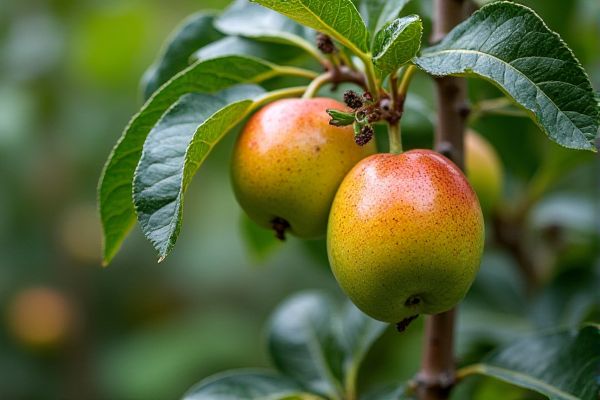
Espalier fruit trees maximize space by training branches flat against a support, making them ideal for small gardens and enhancing fruit production through better sunlight exposure. Discover how choosing between espalier and standard fruit trees can transform your garden's layout and yield in the rest of this article.
Table of Comparison
| Feature | Espalier Fruit Trees | Standard Fruit Trees |
|---|---|---|
| Growth Form | Flat, trained against a structure | Natural, full canopy growth |
| Space Efficiency | High - ideal for small gardens | Low - requires ample space |
| Maintenance | Frequent pruning and training required | Minimal pruning |
| Fruit Yield | Moderate to high, optimized for sunlight | High, dependent on tree size |
| Aesthetic Appeal | Decorative and architectural | Natural and traditional |
| Sunlight Exposure | Optimized due to flat canopy | Varies with tree height and shape |
| Harvest Ease | Easy, fruit accessible at arm's height | Can require ladders or tools |
| Planting Density | High density planting possible | Lower density, spaced for full growth |
Introduction to Espalier and Standard Fruit Trees
Espalier fruit trees are trained to grow flat against a support structure, optimizing space and sunlight exposure, ideal for small gardens and urban environments. Standard fruit trees grow naturally with a free-form structure, requiring more space but allowing greater fruit yield and easier mechanical harvesting. Espalier techniques enhance air circulation and pest control, while standard trees offer a traditional orchard experience with diverse growth habits.
Key Differences in Tree Structure
Espalier fruit trees have a unique, flat, and horizontally trained structure, often grown against a wall or trellis to maximize space and sunlight exposure. Standard fruit trees grow naturally with a free-standing, rounded canopy that requires more space for branches to spread. The espalier method emphasizes controlled growth with regular pruning, while standard trees develop a fuller, more traditional shape with less intervention.
Space and Garden Suitability
Espalier fruit trees require significantly less space than standard fruit trees, making them ideal for small gardens, patios, or urban environments where space is limited. Their flat, trained growth against walls or trellises enhances sun exposure and air circulation, improving fruit production and reducing disease risk. Choosing espalier trees allows you to maximize your garden's productivity while maintaining an organized and visually appealing landscape.
Fruit Yield and Productivity Comparison
Espalier fruit trees maximize fruit yield per square foot by training branches along a flat plane, allowing better light exposure and air circulation compared to standard fruit trees. Your garden benefits from earlier and more consistent fruit production, as espaliered trees facilitate easier pruning and maintenance, enhancing overall productivity. Standard fruit trees may produce larger individual fruits but require more space and time to reach similar yields.
Maintenance and Pruning Requirements
Espalier fruit trees require more frequent and precise pruning to maintain their flat, trained growth against a support structure, which enhances air circulation and sunlight exposure but demands regular skillful attention. Standard fruit trees have less intensive pruning needs, focusing mainly on removing dead or crowded branches to promote healthy growth and fruit production. Maintenance for espalier trees includes monitoring support systems and shaping, while standard trees benefit from seasonal pruning to optimize yield and tree health.
Pest and Disease Management
Espalier fruit trees offer improved pest and disease management due to their open structure, which allows better air circulation and sunlight penetration, reducing the risk of fungal infections. Their systematic pruning and training facilitate easier inspection and targeted treatment, minimizing pest habitats compared to standard fruit trees with denser foliage. This controlled form also simplifies the application of preventative sprays, enhancing overall orchard health and reducing chemical use.
Aesthetic Appeal and Landscape Design
Espalier fruit trees offer a unique aesthetic appeal by providing a sculptural, space-efficient form that enhances garden design with clean lines and visual interest. Their flat, two-dimensional growth pattern contrasts with the natural, rounded shape of standard fruit trees, making espaliers ideal for small gardens and formal landscapes. Incorporating espalier trees creates striking vertical elements that serve both decorative and functional purposes, seamlessly blending fruit production with modern landscape architecture.
Growth Rate and Maturity
Espalier fruit trees typically have a slower growth rate compared to standard fruit trees due to their training and pruning techniques, which direct energy into fruit production rather than vertical growth. Standard fruit trees grow more vigorously and reach maturity faster, often producing fruit within 3 to 5 years, while espalier trees may take longer to fully develop their characteristic shape and yield. Your choice depends on whether you prioritize quicker harvest times or prefer the space-saving, aesthetic appeal of espalier training despite slower maturity.
Cost and Investment Considerations
Espalier fruit trees generally require lower initial investment due to their smaller size and reduced space requirements compared to standard fruit trees, which need more land and larger infrastructure. Maintenance costs for espalier trees are often higher because of the specialized pruning and training techniques needed to maintain their shape. Over time, espalier trees can offer better cost efficiency in urban or small garden settings, while standard trees may provide higher yields suitable for larger orchards.
Choosing the Right Tree for Your Garden
Espalier fruit trees offer a space-saving solution ideal for small gardens, with trained branches that grow flat against a wall or trellis, maximizing sunlight exposure and improving fruit production. Standard fruit trees require more space and natural airflow but provide a fuller canopy that supports higher overall yield and biodiversity. Selecting between espalier and standard fruit trees depends on available garden space, aesthetic preferences, and maintenance commitment for optimal growth and fruit harvest.
 homyna.com
homyna.com